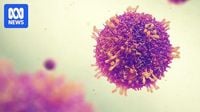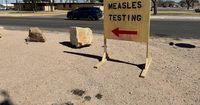The United States has surpassed 1,000 measles cases for the first time in five years, according to new data from the Centers for Disease Control and Prevention (CDC) published on May 9, 2025. A total of 1,001 cases have been confirmed across 30 states, with Texas accounting for the majority of these infections.
The last time the U.S. recorded more than 1,000 cases was in 2019, when there were 1,274 confirmed infections. The current outbreak has raised alarms among health officials, as it marks a significant resurgence of a disease that was declared eliminated in the U.S. in 2000.
As of now, 13% of measles patients have been hospitalized this year, with the majority of those affected being under the age of 19. Alarmingly, about 96% of the confirmed cases are among individuals who are unvaccinated or whose vaccination status is unknown. Only 2% of cases have been reported among those who received just one dose of the measles, mumps, and rubella (MMR) vaccine, while another 2% have received the required two doses.
Texas has been particularly hard-hit, with at least 709 cases confirmed as of May 9. The Texas Department of State Health Services reported that 92 patients have been hospitalized, and tragically, at least two unvaccinated school-aged children have died as a result of the outbreak. Both children had no known underlying health conditions, highlighting the severe risks associated with measles.
Additionally, a third death related to measles has been recorded in New Mexico, where an unvaccinated adult tested positive for the virus after passing away. New Mexico has reported at least 71 cases, primarily in Lea County, which borders Texas. The cases in both Texas and New Mexico reflect a troubling trend, as most infections are occurring among those who are unvaccinated.
In response to the outbreak, the CDC has reiterated its recommendations for vaccination. The agency advises individuals to receive two doses of the MMR vaccine, with the first dose given between 12 to 15 months of age and the second between 4 to 6 years old. According to the CDC, one dose of the vaccine is 93% effective, while two doses increase effectiveness to 97% against measles.
Despite these recommendations, vaccination rates have been declining. For the 2023 to 2024 school year, only 92.7% of kindergartners received the MMR vaccine, down from 93.1% the previous year and significantly lower than the 95.2% coverage seen in the 2019 to 2020 school year prior to the COVID-19 pandemic.
The CDC has identified 14 outbreaks this year, defined as three or more related cases. These outbreaks have not only affected Texas and New Mexico but have also spread to neighboring states, including Oklahoma and Kansas. Other states reporting active outbreaks include Indiana, Michigan, Montana, Ohio, Pennsylvania, and Tennessee.
In Texas, the outbreak has been particularly concentrated in Gaines County, where 57% of the state's cases have been reported. This community, with a population of approximately 22,892, has seen 403 cases since late January 2025, which is over 1.7% of its residents. The outbreak began in a close-knit, undervaccinated Mennonite community, raising concerns about the potential for further spread.
Health officials have expressed worry about the possibility of the measles virus becoming endemic again in the U.S. due to low vaccination rates and misinformation about vaccine safety. "I think we are still at risk of seeing these numbers at least stay steady, if not continue to increase over time," said Lisa Maragakis, senior director of infection prevention at Johns Hopkins Medicine.
Measles is caused by a highly contagious virus that spreads easily through the air when an infected person coughs, sneezes, or even breathes. The symptoms of measles typically begin with a high fever, runny nose, cough, and red, watery eyes. A rash usually appears three to five days after the initial symptoms, starting on the face and spreading downward.
While most children recover from measles, the disease can lead to serious complications, including pneumonia, blindness, brain swelling, and even death. There is no specific treatment for measles; medical care focuses on alleviating symptoms and preventing complications.
The World Health Organization has observed an alarming 11-fold increase in measles cases in the Americas in 2025 compared to the same period last year. This trend underscores the urgent need for increased vaccination efforts and public health campaigns to combat misinformation about vaccines.
In addition to the U.S. outbreak, North America is facing other measles outbreaks. Ontario, Canada, has reported 1,440 cases from mid-October through May 6, 2025, while the Mexican state of Chihuahua has recorded 1,041 cases and one death as of May 9, 2025.
As the U.S. grapples with this resurgence of measles, health officials are calling for communities to prioritize vaccination and educate parents about the importance of immunizations for their children. The fight against rising measles cases is being hampered by a lack of strong advocacy for vaccination and the spread of misleading information about unproven treatments.
With the threat of measles growing, the CDC urges everyone to ensure they are vaccinated and to consult their healthcare providers if they have any questions or concerns about the MMR vaccine. It is crucial for communities to achieve high vaccination rates to protect not only individual health but also public health as a whole.


